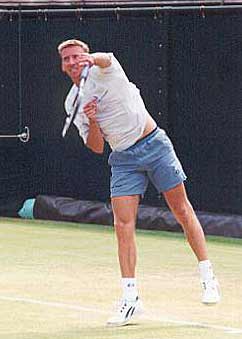|
TennisONE Lessons
Wayne Arthurs, the big serving lefty from Adelaide has quietly risen to the top of the leader board in the ATP match fact statistics categories. Arthurs, 32, is 6’3” and owns a wicked and equally reliable serve. Playing 47 matches in 2002, Arthurs won 24 while losing 23 (which probably shows that either the serve isn’t everything, or there are serious issues with his return of serve). In service categories, Arthurs was ranked as follows:
To balance out these statistics, Hewitt as we would suspect, leads most categories in return of serve proficiency. Hewitt was ranked as follows:
Arthurs' service delivery was slow and easy. In contrast to many of the players with deep knee bends, or a jumping action into the serve, Arthurs was grounded and appeared to use his knees for rhythm instead of power. It appeared that the heaviness of Arthurs’ serve owed more to his body weight against the ball, than Roddick’s vigorous service whip. And I say appeared, for it is difficult to discern the relationship of these variables as they contribute to the serve. Further, the opinions held by coaches and teachers are diverse and conflicting, so I am not always sure what I know in this area, though I still have (obviously) the courage (or foolhardiness) to write about it. So, what can we mere mortals learn from this delivery?
Develop an easy rhythm without a service hitch. Arthurs starts his motion slowly and builds continuously to contact, without a stop or interruption in the swing. To develop a smooth, easy rhythm, try the "two count method." Take a full practice swing using a relaxed tempo, but with an imaginary toss. Call this count one. For count two, repeat count one, only this time with a real toss. Try to imitate the rhythm and feel of count one. Often, count two is hurried and tight whereas count one is flowing and smooth (because there was no ball to hit). The goal is to have count one and count two become identical. Toss the ball well in front. Arthurs leans well into the court, and places the toss in front and to his left. When practicing serves, place your ball cart well in front of you, so it is easy to move into the court as you hit the ball, if only to enable you to reach forward into the cart for the next ball. Hold the racquet loosely and with an eastern backhand grip. The more you are willing to move the grip in this direction, the greater the results at the top of the swing. Indeed, the legendary Pancho Gonzalez recommends when learning the serve, “Use the eastern backhand grip, no matter how difficult to learn, once mastered you will serve with spin, speed, and disguise.” To master this grip, practice serving from no-man’s land, where there is no real target, no penalty for loss of control, and total freedom to experiment. Somehow aiming the serve inhibits the learning of this type of grip. Here's a drill that will help you get the feel of a "loose, flowing swing" as opposed to one that is tight, muscular or forced. Experiment with the following: Move your hand down off the handle so either your pinkie or your pinkie and ring finger are both off the end of the handle. With only the thumb, forefinger, and middle finger holding the racquet, try the two count drill from no-mans land again. Somehow the last three fingers of the hand are the strongest or gripping fingers (you can actually do pull-ups with just these three fingers but you could never do a pull-up with the thumb forefinger and middle finger), so eliminating them from the grip loosens the feeling and encourages the whip.
Years and years ago, my first teacher, Blackie Jones, could perform this serving trick using only his thumb and forefinger, something I still try and emulate. Once this loose, easy swing becomes comfortable, try putting it all
together. Find a practice partner who agrees to return your serves down
the middle so you can rehearse the serve and volley. Then return the favor
and allow your partner to serve and you place the returns down the middle.
(For related materials on the rhythm of the serve, refer to the
Quantum Swing in the TennisONE
Lesson Library.) Your comments are welcome. Let us know what you think about Jim McLennan's article by emailing us here at TennisONE.
|





